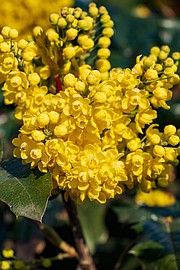Hedges offer beauty, privacy and enhancement
Many years ago, I wrote of hedgerows — the type that once bordered cultivated fields in the U.S. and still exist in great numbers in the British Isles. Today, I tone down that beautiful practice into a very practical land-scape planting consideration, hedges.
Hedges as property line borders, as separation of the garden/home landscape into “rooms”, and as useful dividing lines between the veggie or ornamental gardens and lawn area are a simple solution for many privacy/enhancement issues.
Perhaps you seek to downsize your lawn area to a manageable, more livable space. Simply create the borderline on a paper plan, and then decide if you want a visible, welcoming spot, perhaps with tables and chairs for lounging over lunch or barbecues with friends, or a secluded retreat for reading or a quiet evening of birdsong.
If the former, consider our native Pachistima (Mountain Lover) — nicknamed Oregon box — and hardier than boxwood for our climate. Easily pruned and ever-green, it provides pretty tiny pink blooms early in the season and shiny serrated green leaves year-round for a perfect hedge. Further, it entwines with itself beautifully to deter folks from breaking through at mid-points (rude, yes, but often done).
Another possibility, pictured above, is Cotoneaster, which offers wider-spreading and lower-growing branches with bright green leaves covered — after small spring flowers — with long-lasting red berries that brighten the winter scene.
For a lower, but equally efficient, border, Oregon Grape (Berberis/Mahonia) is ideal. Another native, its glossy, holly-like leaves, clusters of fragrant yellow flowers and blue grape-like berries (great for jelly) give year-round interest since the leaves turn red and gold in the fall through winter. Oregon Grape comes in two growth styles, creeping (Reptans) and tall (aquifolium) and interplanting is a good idea for a nearly impenetrable hedge when properly pruned.
These first three choices are nearly carefree, accepting lean, acidic soil and wanting no fertilizer or pesticides. Softer — but nearly as hardy — beauty can come from choosing a border of shrub or blanket roses.
Stay with one color/species for a unified look and plant a bit closer together than recommended. Be sure to select roses hardy to our Zone 3-4-5 and remember the nasty early-season freezes we often get before snow cover comes. This is killer stuff, and your roses need to be able to take it. Don’t be talked into hybrid teas, et al, and DON’T buy roses in boxes for big box stores! As a matter of fact, when selecting all of your plant choices, buy from a local reputable nursery or greenhouse and take advantage of the owners’ knowledge.
Since nearly all of our suggestions can seem to offer stepping-through spaces until fully established, take your own steps to avoid this possibility. Make it easy to enter your lawn space through the proper egress; perhaps a path leading to a small swinging gate, or even a trellis. If these are not on your agenda, a few stepping stones leading through the entrance should mark the way nicely.
Sanctuary hedging is a different matter. Here’s where you want tall, lush bushes/shrubs. Roses are great for this, especially the hardy, thick-growing Rugosas. Our native Red Osier dogwood (Cornus) is another possibility, also available in yellow-stem, each of which offers lovely winter color once the greenery is gone.
Classicists will perhaps opt for Forsythia — a great choice for thick growth and glorious yellow spring flowers, but also look into the great variety of Viburnums with flat-faced flower heads that bring about bird-luring berries. Our native Syringa or Mockorange (Philadelphus lewisii) is a natural as well, offering hardiness, bright greenery that turns red in fall, and dreamily fragrant blossoms.
If borders aren’t in your book, but you like the idea of a hedge, how about using a great melange of red, yellow and black raspberries in a gorgeous edible hedge between the veggie garden and the living area? Or separation of the ornamental gardens with a living fence of your choice of a non-flowering hedge like the afore-mentioned Pachistima or perhaps native Willows (Salix) like Coyote or Arctic — fast-growing, graceful and easily prunable, or even low-growing Juniper (J. procumbens) covered with rambling Clematis, Honeysuckle or climbing roses?
Now, if your hedge purpose is property delineation, you want to go with heavy-duty growing habit. As in all things, natives serve the purpose best, and the afore-mentioned Osiers (Cornus) serve admirably, providing beauty as well as practicality. The Rugosa roses are great for this purpose, too, offering thorns as well as brushy entanglement.
Our native dwarf Mountain Ash (Sorbus scopulina) is also a pretty (and tough) possibility, and its habit of forming a many-stemmed shrub is a plus. Its berries draw winter birds, and only the possibility of its sprout-ing in the wrong direction could be a negative. However, if you plant in carefully delineated rows (and take periodic walks to pull out (and replant) suckers, you will love this beautiful shrub/tree.
Actually, property line plantings must depend on the location. If you’re in the boonies, I’d suggest going for broke and making a true hedgerow. On smaller property plots, consideration of your neighborhood (and neighbors) must be part of the plan.
Check out your site and desires, keeping in mind your soil type, sun/shade, and existing plantings, look at garden magazines for inspiration, and make your choices. Many people don’t give thought to the possibility of a hedge in the landscape — and perhaps it may be the answer to what you’re looking for.
(Editor’s note: For many years, Valle Novak wrote gardening and cooking columns for the Daily Bee. “Weekend Gardener” and “Country Chef” became renowned for their humor, information, and common sense advice on how to do everything from planting to cooking. While she recently passed away, she has left behind a number of columns to share with and delight her many fans. This is one such column and was originally published on March 2010.)





